Unpacking and publishing the Phaistos Disk since 1993
HOME | PREVIOUS | NEXT | SITEMAP
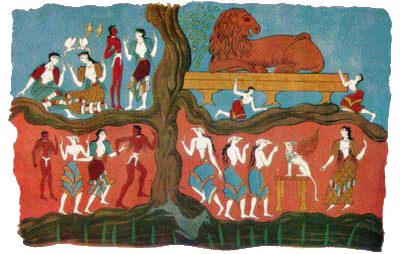
Out in the deep dark sea there lies a land called Crete, a rich and lovely land,
washed by the sea on every side and boasting ninety cities. One of these cities is called Knossos, and there King Minos ruled and enjoyed the
friendship of almighty Zeus. (Homer)
The Aegean world at the
probable time of the creation of the Phaistos Disk was dominated by Egypt and their theology, yet the tiny island-country of Crete established itself in
history as perhaps more remarkable than Egypt. (Click image for larger view) Still, they were much influenced, as was all the
Aegean world, by the Egyptian system of gods and goddesses, particularly the god Horus, an ancient Egyptian sky god from the last part of the Stone Age
who had been worshipped since 4,000 years before the Phaistos Disk was created.
She had conceived him while she fluttered in the form of a hawk over the corpse of her dead husband.
The infant was the younger Horus, who in his youth bore the name of Harpocrates, that is, the child Horus.
(Frazer, Chap. 38)
The disk exists as a unique record of the world in which Daedalus lived about 1600 BCE. It also is the only pottery artifact
to be found in Crete that was not sun-baked but fire hardened as though fired in a kiln. Most likely Daedalus invented a kiln to bake it but
the kiln no longer exists. Alternately, it could have been fired in Egypt in one of the many pottery factories there. Since its discovery in 1908,
the disk has been studied by many people who have been completely baffled by it, so it symbolizes chaos in this respect. Chaos is also the infinity
of space or formless matter that is said to have preceded the existence of the ordered universe and which the Great Geometer organizes with geometry.
Allow the disk to represent that chaos, so that the disk is the universe or world-disk that the sky god Horus holds in his claws, making of it a
Minoan version of a Winged Disk of Horus.
Today the chorus is singing, "This is the dawning of the Age of Aquarius," but when the disk was created it was the dawning of the
Age of Aries. The Greek legend of Jason and the Argonauts comes from the Age of Aries. It was preceded by the Age of Taurus, supposed to have
been between 4320-2160 BCE (4525-1875, dates vary). An Age, lasting about 2,000 years or so, receives its name from the sign through which the
sun passes year after year as it crosses the equator at the Spring equinox (equal night), when night and day are equal in length all over the world,
each lasting 12 hours on this day.
The idea of the bull-god
is foreign to many of us, although it should not be. Even today in India the bull is sacred, and in Spain and Mexico bull sports are still popular, as are
rodeos in the U.S. In Crete, the bull apparently was at the center of both religion and sport. This history of bull-worship clears up some of the mystery
of the Minoan legend of the Minotaur, a bull being at the center of the bull sports and the maze. It clears up some mystery about Zeus, the Greek
god who often appeared as a bull. And it also shines some light on the worship of the bull-born Dionysis. (Above, Bronze Age palace
groundplan at Mallia, Crete compared with bull's head)
Here is the old formula for a son of god in the Bronze Age, when people believed the divinity of a human could be demonstrated by
bull's horns. When the Minotaur - half bull, half human - was born, his parents King Minos and Queen Pasiphae set up the palace at Knossos with
horns along the roof to establish that a divine son of Zeus lived in the palace.
During the Mediterranean Bronze Age, the Aegean people were making a transition from the Age of Taurus and old religion of
bull-worship to the Age of Aries. This was no less a transition from a primitive, idolatrous religion to the beginnings of a scientific-philosophic
world-view, their ascendency over the bull dramatized perhaps by the bull sports at the center of their festivities (right).
When the shift comes and the ages change from Taurus to Aries, the worship of the bull is not transferred to the worship of the ram, but becomes
instead a quest for god/dess, who is conceived of in such a way as to be sought after.
Perhaps this seeking after the goddess motivated the development of the astronomy in Minoan Crete, with the idea that if we
invent telescopes and binoculars and astronomical measuring devices, we can seek the goddess through seeing her, getting closer to her and
knowing her well. Perhaps this astronomical questing for the divine led to our recognition of the universal powers of time and infinity and
the higher powers of destiny, conclusions about such things we might have drawn from stargazing. For the Aegean people, these eternal powers
seemed to emanate from the stars, and it stands to reason that the biggest star, Sirius, must be the most powerful. Therefore, from this star,
an eternal and perfect goddess high in the sky, flow all the gifts in heaven and earth.
With this new power come the wealth, ease and abundance that we associate with the Minoan civilization, a phenomenal flower
that blossomed in the middle of the Aegean Sea. The Greek creation myth tells the story of how it came to pass that the people were so blessed.
It was because the goddess gave them a son, who in turn overthrew the old gods. It is not yet the Age of Pisces when the gift is the son of god.
It is the Age of Aries when the gift is the son of goddess.
In Crete there were three outstanding forms of the mother-goddess -- the
snake-goddess, the dove-goddess, and the "lady of wild creatures"...But there can be no doubt that the conception of the Mother was an
essential part of the Cretan faith...The great goddess was depicted wearing a flounced gown suspended from her
slim waist, round which a girdle is clasped. The upper part of the
body is bare, and she has enormous breasts. Sometimes she stands on a mountain
top, guarded by two great lions, and sometimes she is seated beside trees or
plants. In addition to the lions, her wild animals include the wild goat, the horned sheep, the
bull, the red deer, the snake, and the dove; and among the symbols associated
with her are the horns of the bull, the double axe, the sacred pillar, the moon
crescent, and a staff or wand. She was apparently a goddess of death, battle,
fertility, and the chase. Offerings were made to her in a mountain-cave she was
supposed to inhabit. (Myths of Crete and Pre-Hellenic Europe, Donald Mackenzie)
By looking up into the dome of night, Daedalus and other Minoan astronomers saw the movement of the stars, those great powers
watching over them as they traveled in a whirl. They saw the star Sirius, the goddess of the heavens surrounded by her shields, the planets.
We can understand much more about the Phaistos Disk if we grant that some of this Minoan theology, which we have to reach through Greek mythology to
access, is portrayed on the disk, which therefore describes a universe comprised of two parts, heaven (above, side 1) and
earth (below side 2), both filled with many souls and other things that are moving in a whirl as do the stars. Later on in
time, mystics would say that a Great and Powerful Hand was stirring the cosmos round and round into a whirl, and this is the beginning of making
sense of chaos by separating the individual parts into their proper places or realms via spin. These realms were under the dominion of the
shields or planets, which the Greeks would later call Archons, the planetary rulers and their aeons.
Opposing the Light and Life of Sirius was Tartarus, the realm of the kingdom of Darkness and Death, ruled by Hades. In Egypt,
the Underworld was ruled first by the evil serpent Typhon, who is related to Draco, the constellation of the Dragon, and Tiamat (Draco), whom
Marduk battles in old Babylon. Draco, Tiamat and Leviathan, the dragon of the sea, are early depictions of what became in Biblical times the
serpent in the Garden of Evil.
In the Babylonian religion, its influence perhaps seen on the Phaistos Disk, Earth is the battleground of Good and Evil, as
Marduk and Tiamat struggle for human souls. This is mirrored in Egyptian mythology in the conflict of good-doing Osiris and wicked Typhon,
gods of ancient Egypt. Osiris is like Marduk, the supreme Babylonian god who vanquishes Tiamat and the forces of chaos. Osiris eventually
triumphs over Typhon and comes to reign in his stead in the realms of the underworld. Osiris displaces Typhon so that the dead become the
living once again, either recycled via reincarnation back onto this planet or else passed into eternal life through the portals of Amenti and
into the dawn of Sirius. Although Typhon first rules the underworld realms of Darkness, his plan to murder his brother Osiris eventually
backfires when Osiris becomes ruler of the underworld and becomes the Power over all that is capable of transfiguring a soul from death unto
rebirth. This myth, in which one brother murders another, is mirrored in Chrisitianity in the story of Cain and Abel.
Reigning high above all this earthly and celestial drama of good and evil is the great star Sirius (Isis/Rhea) and her son,
Sirius B or Horus-in-the-Duat, which the Egyptians and the Minoans may have known about. But Sirius itself is more than mere star; it is an Aeon,
a divine being in its divine realm. The star is Great Mother and it also is a god among starry gods, who are themselves vast and divine Aeons.
Within them one can live and continue to learn, even after death. Below the sphere of the divine star revolve the seven rulers, the planets.
From our planet, the planet of the mortals, is given only that we should find a way to somehow come closer to the star Sirius, to admire it and
to worship it, as is given us mortals to do. To accomplish this, perhaps we build a great pyramid so we may sit at the top of it and gaze upon
the star with our telescopes. As we admire Sirius from the vantage point of our pyramid, we also
see the constellation Argo, the ship of Jason and the Argonauts, the Boat of Ra, the Bark of Osiris that
sails across the night skies and across the surface of the Phaistos Disk.
The Phaistos Disk also seems to be an ancient representative of angels and angles and their correspondences, bounded by a
circle and alchemically mixed in a whorl. Spinning round and round they take human form, and perhaps this stands as the old definition of
what it means to be human, what it means to be a mixture of spirit and matter all at the same time and bounded by a universe we can never comprehend.
This is consistent with spiritual beliefs of a much later time regarding life as being alchemically bounded and contained either by the circle or
the triangle. This archaic religion, the remaining parts of it known to us now as Hermeticism, recognized other correspondences as well, such as
the relationship of the night skies of the Northern and Southern Hemispheres to the right and left sides of the brain (two sides of the disk).
It recognized correspondences between the spiraling path of star Sirius through the constellations and the spiraling descent of divine starlight
from that star (spirals on the disk). It saw a correspondence in the return of the physical body to ashes and dirt and in the return of the
living soul to its Source in the realms of the star, where there is an eternal dawn. According to this theology, these relationships or
correspondences can be represented by geometry. The entire universe and its drama can be represented by geometry, and this is what makes it
the Sacred Science.
From this Sacred Science arises the legend of the Trismegistus, Thrice Greatest Hermes - all those scholars and seekers who met
the Transcendent when they finally realized "I Am That." This is the heart and soul of the alchemy - the fusion - of the harmonious opposites.
And in these sixty spaces dwell the souls, each one according to its nature, for though they are of one and the
same substance, they are not of the same dignity. (Plutarch) Many early civilizations created art designed to describe the layout of the universe and humanity's position within it,
and much of it had to do with the spiral. It is as though once the spiral design was discovered and used in art, it began to be perceived as
representing a higher form or archetype upon which all reality was based. The Phaistos Disk, in my opinion, is one of those designs that shows
the spiraling nature of reality, but what sets it apart from all the rest is that it is a very detailed description of the world preserved on a
hardened clay disk and it also exists as an historical record of the great flood that threatened to destroy the superficial world created by humans.
Although the spirals on the disk appear to be flat concentric circles in a two-dimensional plane, the possibility exists they
represent height as well, especially considering the evidence offered by the two pyramids concealed on the artifact. The intention might be for
the spirals to represent something like this ziggurat below.
2100 BCE in Mesopotamia, the ziggurat of Dur Sharukin (below left, my tracing), was built as a
residence for the god during his/her descent to earthly sojourn. Both the ziggurat and the Phaistos Disk show five spirals, with the top of the
pyramid on the Phaistos Disk indicated by the pictograph of the Golden Fleece, belonging to the ram sacrificed to Zeus, that Jason and the
Argonauts pursued. In this respect, the Golden Fleece symbolizes Zeus.
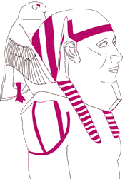
![]() In Egyptian mythology, Horus sat on the shoulder of the
pharaohs and imparted to them his genius. Each pharaoh had a "Horus name" as part of the royal title, and it is possible that the Great Pyramid was
dedicated to him. Eventually Horus' identity merged with his father Osiris, whose identity merged with Dionysis of Crete. In this transformation of
myth, Dionysis is occasionally merged with Daedalus. We might conclude that the genius of Daedalus was due in part to Horus, a winged supernatural
being who "sat on his shoulder", i.e., merged with him via an alchemical fusion, as in this image of the Pharaoh Kephren (right).
These correspondences might place the creation of the Phaistos Disk in the time of Kephren. We now know that the Minoan and Egyptian civilizations
were amicable. Most likely they were in agreement as to the identity and nature of this god, especially since he had for so long taken so many
different forms and evolved alongside the people who worshipped him.
In Egyptian mythology, Horus sat on the shoulder of the
pharaohs and imparted to them his genius. Each pharaoh had a "Horus name" as part of the royal title, and it is possible that the Great Pyramid was
dedicated to him. Eventually Horus' identity merged with his father Osiris, whose identity merged with Dionysis of Crete. In this transformation of
myth, Dionysis is occasionally merged with Daedalus. We might conclude that the genius of Daedalus was due in part to Horus, a winged supernatural
being who "sat on his shoulder", i.e., merged with him via an alchemical fusion, as in this image of the Pharaoh Kephren (right).
These correspondences might place the creation of the Phaistos Disk in the time of Kephren. We now know that the Minoan and Egyptian civilizations
were amicable. Most likely they were in agreement as to the identity and nature of this god, especially since he had for so long taken so many
different forms and evolved alongside the people who worshipped him.
 In Egyptian mythology, the god
Horus is represented by the golden hawk, who flies nearest the sun, and gazes upon it with unwinking eye.
(G.R.S. Mead, Thrice-Greatest Hermes, Vol I, p.53) The hawk carries in its claw the
Bone of Horus, (Plutarch in Mead, Vol. 1, p.238) the naturally occurring magnet called the lodestone and
bone of the sea-hawk. (Ibid)
In Egyptian mythology, the god
Horus is represented by the golden hawk, who flies nearest the sun, and gazes upon it with unwinking eye.
(G.R.S. Mead, Thrice-Greatest Hermes, Vol I, p.53) The hawk carries in its claw the
Bone of Horus, (Plutarch in Mead, Vol. 1, p.238) the naturally occurring magnet called the lodestone and
bone of the sea-hawk. (Ibid)
![]() Much later on in Egypt, concurrent with the Phaistos Disk and during the Age of Aries, Horus is the Great
Geometer of the ancient Egyptian world, the god who creates the world-disk and then flies away with it, lifting it into space and making it the Winged Disk.
He is also the magical power of resurrection, capable of flying with a person's Ka or spirit-soul to the higher realms of the afterlife. Horus has eyes to
see the world entire and the geometry underlying its construction, and if we have Eye of Horus we can magically see it too. Daedalus, as a man true to
his times, would most likely be much influenced by the theology associated with the sky god Horus, and we can see this influence on the Phaistos Disk.
Much later on in Egypt, concurrent with the Phaistos Disk and during the Age of Aries, Horus is the Great
Geometer of the ancient Egyptian world, the god who creates the world-disk and then flies away with it, lifting it into space and making it the Winged Disk.
He is also the magical power of resurrection, capable of flying with a person's Ka or spirit-soul to the higher realms of the afterlife. Horus has eyes to
see the world entire and the geometry underlying its construction, and if we have Eye of Horus we can magically see it too. Daedalus, as a man true to
his times, would most likely be much influenced by the theology associated with the sky god Horus, and we can see this influence on the Phaistos Disk.
![]()
 In the Age of Taurus the bull was worshipped as divine. After
perhaps as many as 25,000 preceding years of bull worship, it is not surprising that the bull figured significantly in the Minoan civilization. A bull's
foot appears twice on the Phaistos Disk (left). Egypt had its Serapis, the sacred Osiris-Apis bull. Baal was widely worshipped,
later on the Israelites had their golden calf Moshe (Moses), and painted on the walls of buildings in ancient Sumer are humans with horns. The horns tell
of their status as gods and goddesses. (Minoan Queen Pasiphae drawn by Picasso, right)
In the Age of Taurus the bull was worshipped as divine. After
perhaps as many as 25,000 preceding years of bull worship, it is not surprising that the bull figured significantly in the Minoan civilization. A bull's
foot appears twice on the Phaistos Disk (left). Egypt had its Serapis, the sacred Osiris-Apis bull. Baal was widely worshipped,
later on the Israelites had their golden calf Moshe (Moses), and painted on the walls of buildings in ancient Sumer are humans with horns. The horns tell
of their status as gods and goddesses. (Minoan Queen Pasiphae drawn by Picasso, right)
![]()
![]() In the Age of Aries the bull-god
gives over to the ram, whose Golden Fleece is the object of the quest of Jason and the Argonauts. They stopped worshipping the bull - in fact, they slayed
the bull in Crete, or Theseus did, in the legend of Theseus and the Minotaur. Following the Age of Aries is the Piscean Age in which a divine fish
symbolizes the Son of God as the "fisher of men." As we move into the Age of Aquarius, the cup is the symbol of the divine and holds the Water of Life, and
the Knights of the Round Table quest for the Holy Grail. One way or another, either directly or indirectly, we are influenced by the stars. Are they
really eternal, divine powers moving in a whirl and from whose dominion there is no escape?
In the Age of Aries the bull-god
gives over to the ram, whose Golden Fleece is the object of the quest of Jason and the Argonauts. They stopped worshipping the bull - in fact, they slayed
the bull in Crete, or Theseus did, in the legend of Theseus and the Minotaur. Following the Age of Aries is the Piscean Age in which a divine fish
symbolizes the Son of God as the "fisher of men." As we move into the Age of Aquarius, the cup is the symbol of the divine and holds the Water of Life, and
the Knights of the Round Table quest for the Holy Grail. One way or another, either directly or indirectly, we are influenced by the stars. Are they
really eternal, divine powers moving in a whirl and from whose dominion there is no escape?
![]()

![]()
![]()
![]()
![]()
![]()
![]()
![]()
![]()
![]()
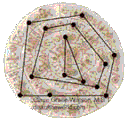
![]() Daedalus, to be such an extraordinary inventor, would have been a renaissance man of his own times, knowledgeable not
only in the theology of the people but also in astronomy and geometry, the laws of physics of the ancient world. These sciences involved not
just the stars and constellations but also the positioning and influences of the 7 planets that included the sun and the moon. In Egyptian
mythology, the sun was one Eye of Horus and the moon the other. The study of these integrated sciences is said to have originated in Babylon,
Assyria, and Egypt, but we need to add Crete to that list. This scientific-philosophic view of the universe probably involved a widely accepted
belief system of an "as above, so below" relationship of the stars to the people (left). In this belief system, the people
and everything that happened were under the influence of the stars and planets, who also offered them eternal life.
Daedalus, to be such an extraordinary inventor, would have been a renaissance man of his own times, knowledgeable not
only in the theology of the people but also in astronomy and geometry, the laws of physics of the ancient world. These sciences involved not
just the stars and constellations but also the positioning and influences of the 7 planets that included the sun and the moon. In Egyptian
mythology, the sun was one Eye of Horus and the moon the other. The study of these integrated sciences is said to have originated in Babylon,
Assyria, and Egypt, but we need to add Crete to that list. This scientific-philosophic view of the universe probably involved a widely accepted
belief system of an "as above, so below" relationship of the stars to the people (left). In this belief system, the people
and everything that happened were under the influence of the stars and planets, who also offered them eternal life.
 In Greek mythology of a much
later period than the Phaistos Disk, but which we think comes from Minoan mythology, we have the story of the great darkness Chaos, who reigned until it
separated into Earth (side 1 of the disk) and Heaven (side 2 of the disk), who embraced each other (the two sides connected by the line segments). From
this embrace came many children, among them the Titans (the circles or shields containing the 7 tiny circles in hexagonal pattern that represent
the 7 planets, left).
In Greek mythology of a much
later period than the Phaistos Disk, but which we think comes from Minoan mythology, we have the story of the great darkness Chaos, who reigned until it
separated into Earth (side 1 of the disk) and Heaven (side 2 of the disk), who embraced each other (the two sides connected by the line segments). From
this embrace came many children, among them the Titans (the circles or shields containing the 7 tiny circles in hexagonal pattern that represent
the 7 planets, left).
 Some of the
Titans were the planets of the known universe but there was strife among them. Chaos reigned again until the Titan Kronos took the throne by force from his
father and then married his sister Rhea, like the way the Egyptian Osiris married his sister Isis. The universe was peaceful and orderly for
many thousands of years until life began to form in Rhea's womb that was a vast vortex and mighty whirlpool. Into the soul spaces of the vast
vortex, Rhea (star Sirius), in Heaven above, began to pour her children into space-time.
Some of the
Titans were the planets of the known universe but there was strife among them. Chaos reigned again until the Titan Kronos took the throne by force from his
father and then married his sister Rhea, like the way the Egyptian Osiris married his sister Isis. The universe was peaceful and orderly for
many thousands of years until life began to form in Rhea's womb that was a vast vortex and mighty whirlpool. Into the soul spaces of the vast
vortex, Rhea (star Sirius), in Heaven above, began to pour her children into space-time.
 Formed in her womb were 5 main
divisions of layers or cosmic stuff (cosmoi), and into these layers or firmaments formed 60 soul spaces made of 60 types of
soul-stuff, comprising 240 individual souls made of 48 different archetypes. The 5 layers are the spirals on both
sides of the disk (right), the pictographs removed to see the spirals better. Each outside spiral has 12
line segments; 8 inside spirals have a combined 36 line segments. The spirals are divided into 60 line segments
(30 Side 1, 30 Side 2). The 60 soul spaces in Rhea's womb are the total number of line segments on the disk, the 240
individual souls she creates is the total number of pictograph impressions, and 48 soul types is the number of unique signs on the disk.
The 48 soul types may also have been imaged as the constellations, in an "as above, so below" relationship. For example, the Minotaur may have
been the "so below" version of the constellation Taurus. These numbers in bold also reveal the mathematics of the times that may have involved
the sexagesimal system of counting, perhaps with calendar applications.
Formed in her womb were 5 main
divisions of layers or cosmic stuff (cosmoi), and into these layers or firmaments formed 60 soul spaces made of 60 types of
soul-stuff, comprising 240 individual souls made of 48 different archetypes. The 5 layers are the spirals on both
sides of the disk (right), the pictographs removed to see the spirals better. Each outside spiral has 12
line segments; 8 inside spirals have a combined 36 line segments. The spirals are divided into 60 line segments
(30 Side 1, 30 Side 2). The 60 soul spaces in Rhea's womb are the total number of line segments on the disk, the 240
individual souls she creates is the total number of pictograph impressions, and 48 soul types is the number of unique signs on the disk.
The 48 soul types may also have been imaged as the constellations, in an "as above, so below" relationship. For example, the Minotaur may have
been the "so below" version of the constellation Taurus. These numbers in bold also reveal the mathematics of the times that may have involved
the sexagesimal system of counting, perhaps with calendar applications.
![]()
![]() The Minoans seem to have assimilated, through
cultural diffusion, parts of various theologies of the times from Egypt, Mesopotamia and perhaps other local civilizations. For example,
the five-branched tree, the ancient Chaldaean (Mesopotamian) symbol for the human purified, that appears on the Phaistos Disk
(left) may mean practically the same thing to the Minoans. The Golden Fleece (left)
pursued by Jason and the Argonauts may be a Minoan variation of the five-branched symbol, also meaning purification.
The Minoans seem to have assimilated, through
cultural diffusion, parts of various theologies of the times from Egypt, Mesopotamia and perhaps other local civilizations. For example,
the five-branched tree, the ancient Chaldaean (Mesopotamian) symbol for the human purified, that appears on the Phaistos Disk
(left) may mean practically the same thing to the Minoans. The Golden Fleece (left)
pursued by Jason and the Argonauts may be a Minoan variation of the five-branched symbol, also meaning purification. 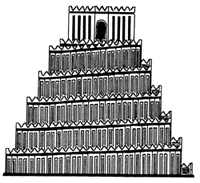

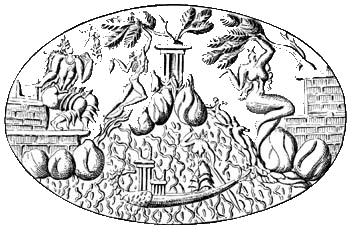
![]() In Mesopotamia the god would descend to the
ziggurat and enter the temple on top, marked by an 'E' and meaning House of the God (perhaps like church, synagogue, temple) and
rest upon the bed provided. On the Phaistos Disk, the "E" symbol (left) appears only twice, on side 1, the
same side as the two pyramids. The symbol appears to mean "As above, So Below" and may have been borrowed from the ancient Sumerian symbol
that marks the House of the God, with the Minoan modification to mean, "Purified House of the God As above, So below." Inscribed on "Ring of Minos,"
right, the temple-tomb atop the mound is purified by the five-branched tree at the top.
In Mesopotamia the god would descend to the
ziggurat and enter the temple on top, marked by an 'E' and meaning House of the God (perhaps like church, synagogue, temple) and
rest upon the bed provided. On the Phaistos Disk, the "E" symbol (left) appears only twice, on side 1, the
same side as the two pyramids. The symbol appears to mean "As above, So Below" and may have been borrowed from the ancient Sumerian symbol
that marks the House of the God, with the Minoan modification to mean, "Purified House of the God As above, So below." Inscribed on "Ring of Minos,"
right, the temple-tomb atop the mound is purified by the five-branched tree at the top.